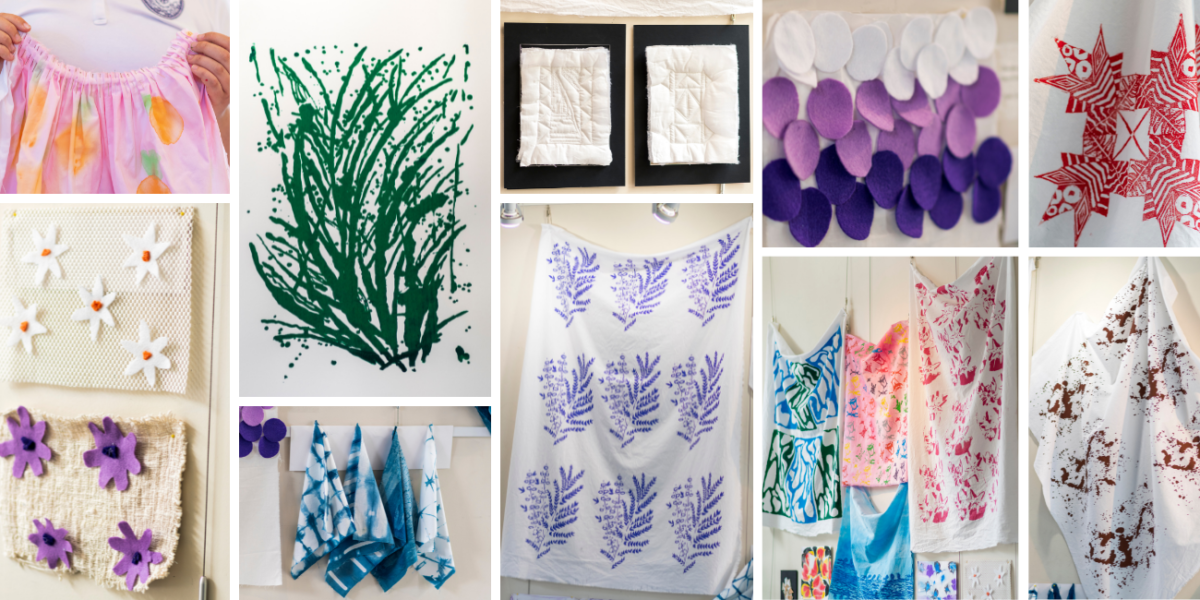
For students in Visual Arts faculty member Lynne Riding’s Honors Surface Design class, mastering the techniques and materials to best manifest their sketches has been only part of their creative journey. In order to truly grow as artists, they have discovered they must look within to embrace the freedom of self-expression and envision designs all their own.
“There is something magical about using a traditional skill and trying to recreate the effect while at the same time developing your own piece of art,” said Riding. “Creating by having one’s hands in the material is very grounding. The unexpected will happen, and if one is open to this, then it is an exciting process.”
Offered for the first time this year, Honors Surface Design introduced students to numerous methods of designing and creating patterns and textures on fabric and paper surfaces, including screen printing, block printing, marbling, Indigo Shibori dyeing, and fabric manipulation of quilting, collage, and dyeing. As Riding points out, surface design is pervasive in the contemporary world, and her goal was for students to gain a deeper appreciation of hand craftsmanship from around the globe.
“A few methods of surface design include Japanese Indigo Shibori dyeing, the heritage of Indigo dyeing here in the Lowcountry, block printing used in India, Bali, Thailand, Africa, and marbling used in Italy,” she notes. “So initially, students researched the prints made in these countries over time and how they are adapted by designers in our contemporary world. This gave them an understanding and appreciation of the various global cultures and the patience and skill required for these various methods and traditions which have been passed down through the generations. We have focused on the hand-applied methods used in different countries, but these patterns, once made, could easily be taken and developed digitally on the computer.”
While learning the foundation of the methods and engaging with different materials, students also have experienced growth in their own creative process. “Ms. Riding has really challenged me to go outside of the box with my designs,” said Georgia Dempsey ’23. “I was challenged to make more abstract drawings instead of the structured floral patterns that are my go-to. I adore working with fabrics and manipulating them into what I want. My favorite fabric technique by far is indigo dying or marbling. You get to make your own pattern and color scheme, and no one else in the world will ever have the same as you.”
Riding’s encouragement to embrace self-expression has been revelatory for students. “Ms. Riding has encouraged me to go beyond what feels safe, to be curious about the possibilities within design, and to express myself through a variety of techniques while using different mediums,” shared Clemmie Anderton ’23. “She taught me the more I am open to the abstract feel of the fabrics, the more creative the process becomes and the ideas flow.” Prior to Riding’s class, Kedi Jiang ’21 had adhered to a realistic style in her artwork without exploring a more abstract interpretation. “I really enjoy the fact that Ms. Riding always tells us to try out things boldly and let our thoughts flow,” said Jiang. “I found it really helpful when I designed my final dress by using a marker instead of a pencil. The methods she taught naturally pushed our creativity. I will continue to use these methods not only for art-related things in the future but also for any kind of projects that need brainstorming.” For Cecily Anderton ’23, Riding’s dedication to her students is key. “I’ve loved doing this class and the projects in it,” she enthused. “This class definitely helped me to imagine and create new pieces of art.”
With hopes to offer Honors Surface Design again this fall, Riding is already making plans. “As part of my professional development this summer, I will be experimenting more with natural dyes from material found locally such as acorns,” she said. Her goal is to always give students the best creative experiences possible so that they may manifest their own self-expression. “I have a wonderful group of students and look forward to this class each week,” she said. “Each student approaches her work with enthusiasm and brings something different to her work. They have all gradually developed their own style of design as their confidence grew, resulting in their personalities coming through loud and clear!” For Riding, that has always been by design.
